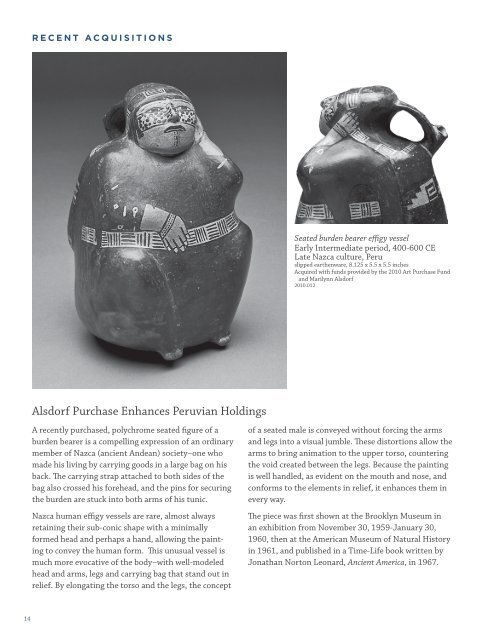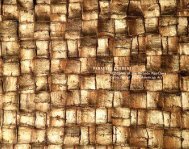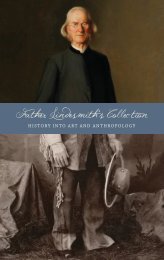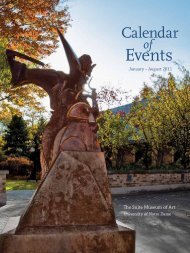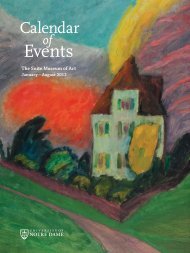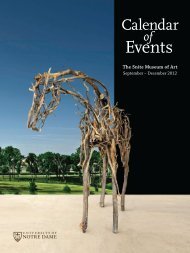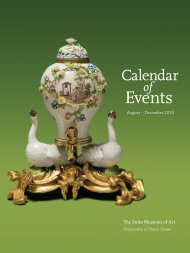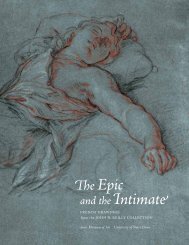The Snite Museum of Art - Snite Museum of Art - University of Notre ...
The Snite Museum of Art - Snite Museum of Art - University of Notre ...
The Snite Museum of Art - Snite Museum of Art - University of Notre ...
Create successful ePaper yourself
Turn your PDF publications into a flip-book with our unique Google optimized e-Paper software.
14<br />
rEcEnt acquIsItIons<br />
Alsdorf Purchase Enhances Peruvian Holdings<br />
A recently purchased, polychrome seated figure <strong>of</strong> a<br />
burden bearer is a compelling expression <strong>of</strong> an ordinary<br />
member <strong>of</strong> Nazca (ancient Andean) society–one who<br />
made his living by carrying goods in a large bag on his<br />
back. <strong>The</strong> carrying strap attached to both sides <strong>of</strong> the<br />
bag also crossed his forehead, and the pins for securing<br />
the burden are stuck into both arms <strong>of</strong> his tunic.<br />
Nazca human effigy vessels are rare, almost always<br />
retaining their sub-conic shape with a minimally<br />
formed head and perhaps a hand, allowing the painting<br />
to convey the human form. This unusual vessel is<br />
much more evocative <strong>of</strong> the body–with well-modeled<br />
head and arms, legs and carrying bag that stand out in<br />
relief. By elongating the torso and the legs, the concept<br />
Seated burden bearer effigy vessel<br />
Early Intermediate period, 400-600 CE<br />
Late Nazca culture, Peru<br />
slipped earthenware, 8.125 x 5.5 x 5.5 inches<br />
Acquired with funds provided by the 2010 <strong>Art</strong> Purchase Fund<br />
and Marilynn Alsdorf<br />
2010.012<br />
<strong>of</strong> a seated male is conveyed without forcing the arms<br />
and legs into a visual jumble. <strong>The</strong>se distortions allow the<br />
arms to bring animation to the upper torso, countering<br />
the void created between the legs. Because the painting<br />
is well handled, as evident on the mouth and nose, and<br />
conforms to the elements in relief, it enhances them in<br />
every way.<br />
<strong>The</strong> piece was first shown at the Brooklyn <strong>Museum</strong> in<br />
an exhibition from November 30, 1959-January 30,<br />
1960, then at the American <strong>Museum</strong> <strong>of</strong> Natural History<br />
in 1961, and published in a Time-Life book written by<br />
Jonathan Norton Leonard, Ancient America, in 1967.<br />
O’Gradys Add Zulu <strong>Art</strong> to African Collection<br />
Robert E. ND’63 and Beverly SMC ’63 O’Grady have recently<br />
made possible the acquisition <strong>of</strong> three elegant, late 19th-century<br />
objects—a prestige spoon and two war clubs.<br />
<strong>The</strong> spoon is a very fine example <strong>of</strong> Zulu geometric composition<br />
and artistic creativity combined with the skilled craftsmanship<br />
required to achieve such a remarkable result.<br />
<strong>The</strong> precision <strong>of</strong> the carving and pyro-coloration, achieved<br />
by burning wood surfaces with a heated tool, is exceptional.<br />
What resembles a stack <strong>of</strong> stylized heads forms the handle for<br />
the teardrop-shaped bowl. <strong>The</strong> hair and beard <strong>of</strong> each head<br />
are the V-shape dark parts; the natural color V-shapes are the<br />
eyes and mouth, while the bottom head on the back is entirely<br />
black. A patina <strong>of</strong> wear has s<strong>of</strong>tened tips <strong>of</strong> the V-forms<br />
just above the bowl–to be expected after a hundred years <strong>of</strong><br />
repeated, but careful, use.<br />
<strong>The</strong> first knobkerrie war club has a spherical head divided into<br />
quarters by two intersecting lines <strong>of</strong> conic brass tacks. <strong>The</strong><br />
shaft gradually expands from its base to the head, with three<br />
decorative bands <strong>of</strong> geometric brass and copper wirework. Its<br />
form and size suggest it belonged to a military leader. But the<br />
weight would prohibit use in combat suggesting, rather, that<br />
it functioned as an authority staff. A patina <strong>of</strong> wear, resulting<br />
from years <strong>of</strong> handling, reinforces this interpretation.<br />
<strong>The</strong> second club is another display <strong>of</strong> the war clubs’ aesthetic<br />
forms for prominent Zulu warriors, having the same general<br />
shape as the first, but smaller and lighter with marks <strong>of</strong> battle<br />
quite evident on it. One could fight all day with this weapon–<br />
indeed, the handle once was extensively pyro-colored, but<br />
years <strong>of</strong> use have worn it away.<br />
Prestige spoon, handle decorated with human head shapes,<br />
1875-1900<br />
Zulu group, Kwa Zulu Natal, South Africa<br />
pyro-colored wood, length 17 inches<br />
Acquired with funds provided by Mr. Robert ND ’63 and Mrs. Beverly SMC ’63 O’Grady<br />
2010.023.002<br />
shown in color on back cover<br />
(Upper right)<br />
Knobkerrie decorated with brass tacks and wirework,<br />
1875-1900 (detail)<br />
Zulu group, Kwa Zulu Natal, South Africa<br />
wood, brass tacks, copper and brass wire, height 21.25 inches<br />
Acquired with funds provided by Mr. Robert ND ’63 and Mrs. Beverly SMC ’63 O’Grady<br />
2010.023.001<br />
entire object shown in color on back cover<br />
(Lower right)<br />
Knobkerrie with four ovoid projections and wirework,<br />
1875–1900 (detail)<br />
Zulu group, Kwa Zulu Natal, South Africa<br />
wood, brass wire, and pyro-coloring, height 21 inches<br />
Acquired with funds provided by Mr. Robert ND ’63 and Mrs. Beverly SMC ’63 O’Grady<br />
2010.038<br />
15


